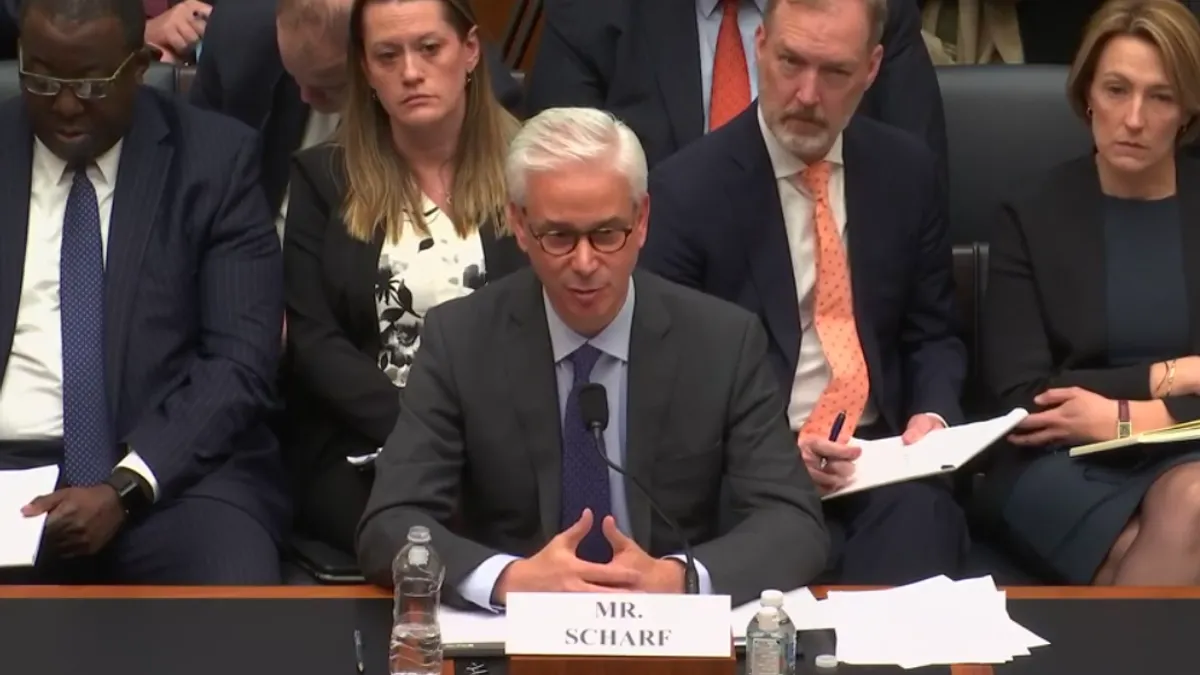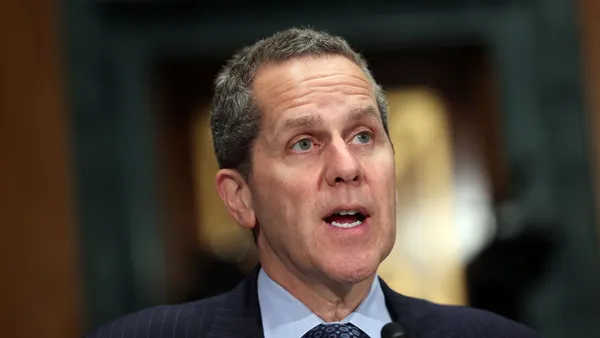Dive Brief:
- With $36.4 million in total compensation for 2019, Wells Fargo CEO Charlie Scharf surpassed his mentor, JPMorgan Chase boss Jamie Dimon, to become the banking industry's highest-paid chief executive, according to an S&P Global report Monday.
- Scharf also had the highest ratio of CEO pay to median employee salary, at 550 to 1, according to the data. Ratios for six of the seven highest-paid CEOs were 200 or more to 1.
- Among the top 10 CEOs listed, IberiaBank CEO Daryl Byrd received the highest increase in compensation — a 91.8% jump to $10.1 million. Memphis, Tennessee-based First Horizon acquired IberiaBank in a $3.9 billion all-stock deal that closed last month, and Byrd is serving as the combined entity's chairman.
Dive Insight:
Scharf’s October transition from the top post at Bank of New York Mellon to Wells Fargo may have influenced the figures. His compensation breaks down to $7.6 million in cash and $28.8 million in stocks granted, according to S&P Global.
His target annual compensation atop the San Francisco-based lender was set to be $23 million, according to a filing with the Securities and Exchange Commission (SEC). That marked a 40% increase from his $16.5 million target pay in his final year at BNY Mellon, according to Bloomberg.
Wells Fargo was also set to give Scharf $26 million in stock as part of a "make-whole award," intended to replace the value of equity compensation awards he would forfeit from leaving BNY Mellon.
Dimon, by comparison, received $31.6 million in 2019 — $7.1 million in cash and $24.5 million in stock. The JPMorgan Chase chief had been the highest-paid banking CEO in each of the previous three years, S&P Global reported.

Investment bank CEOs appear to be absent from S&P Global's data. Goldman Sachs CEO David Solomon received a 19.6% raise in 2019 to $27.5 million, which would rank him third. Morgan Stanley CEO James Gorman would rank fourth with $27 million after taking a 7% pay cut last year.
Among other chief executives at U.S.-based systemically important financial institutions, BNY Mellon's Todd Gibbons received nearly $12 million in compensation. He took over as interim CEO at the bank when Scharf left and was named permanently to the top role in March. State Street CEO Ronald O’Hanley's target total compensation was set at $10.5 million, according to a filing with the SEC.
Truist’s Kelly King and KeyBank's Beth Mooney (both $9.7 million) just missed the top 10. Mooney is the highest-paid woman on the list.
That Wells Fargo's CEO would be the industry’s highest-paid may be a source of controversy in itself. The bank began 2020 with 12 enforcement actions against it — some stemming from a 2016 fake accounts scandal that has eroded customer trust and cost the bank a $3 billion fine. The bank has also generated controversy over "deceptively collected" monthly fees and for allegedly placing some mortgage holders’ accounts in forbearance without their knowledge.
On the other hand, it could be a show of faith or an acknowledgment that the bank has much to do to right itself, and the path won't be easy. The bank took its first quarterly loss since 2008 in this year's second quarter — to the tune of $2.4 billion. Much of that can be attributed to a massive increase in loan-loss reserves.
Since then, Scharf has said he wants to cut $10 billion in costs at the bank. Cutting spending on consultants could account for $1.5 billion of that, according to the Financial Times. But the bank is also reportedly gearing up to cut tens of thousands of jobs beginning this year.
The bank also is still operating under a $1.95 trillion asset cap the Federal Reserve imposed in 2018. In the early days of the Paycheck Protection Program, Wells Fargo said the cap limited the bank’s lending power. Bloomberg data estimates the cap has cost the bank $220 billion in market value.














